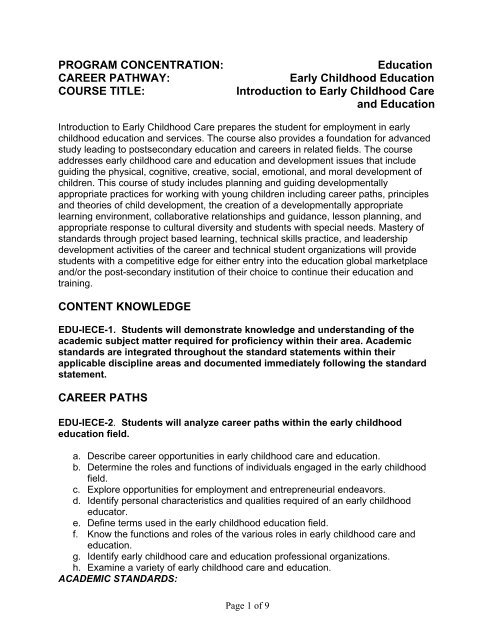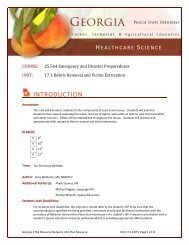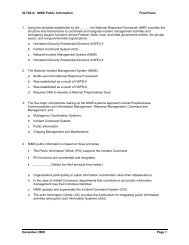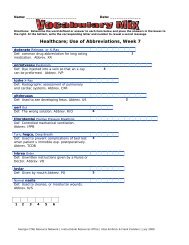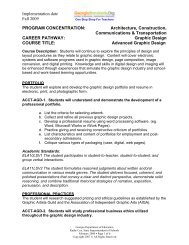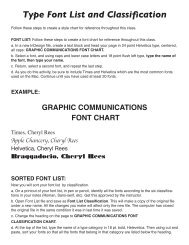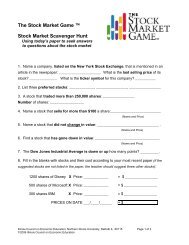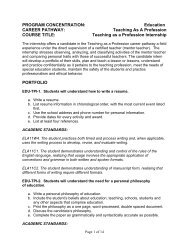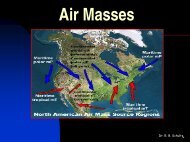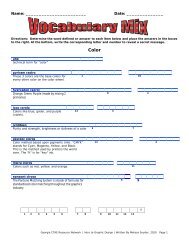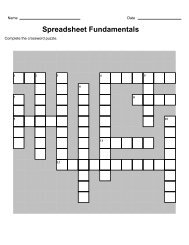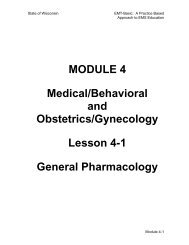Intro To Early Childhood Care & Education
Intro To Early Childhood Care & Education
Intro To Early Childhood Care & Education
Create successful ePaper yourself
Turn your PDF publications into a flip-book with our unique Google optimized e-Paper software.
PROGRAM CONCENTRATION:<br />
CAREER PATHWAY:<br />
COURSE TITLE:<br />
<strong>Education</strong><br />
<strong>Early</strong> <strong>Childhood</strong> <strong>Education</strong><br />
<strong>Intro</strong>duction to <strong>Early</strong> <strong>Childhood</strong> <strong>Care</strong><br />
and <strong>Education</strong><br />
<strong>Intro</strong>duction to <strong>Early</strong> <strong>Childhood</strong> <strong>Care</strong> prepares the student for employment in early<br />
childhood education and services. The course also provides a foundation for advanced<br />
study leading to postsecondary education and careers in related fields. The course<br />
addresses early childhood care and education and development issues that include<br />
guiding the physical, cognitive, creative, social, emotional, and moral development of<br />
children. This course of study includes planning and guiding developmentally<br />
appropriate practices for working with young children including career paths, principles<br />
and theories of child development, the creation of a developmentally appropriate<br />
learning environment, collaborative relationships and guidance, lesson planning, and<br />
appropriate response to cultural diversity and students with special needs. Mastery of<br />
standards through project based learning, technical skills practice, and leadership<br />
development activities of the career and technical student organizations will provide<br />
students with a competitive edge for either entry into the education global marketplace<br />
and/or the post-secondary institution of their choice to continue their education and<br />
training.<br />
CONTENT KNOWLEDGE<br />
EDU-IECE-1. Students will demonstrate knowledge and understanding of the<br />
academic subject matter required for proficiency within their area. Academic<br />
standards are integrated throughout the standard statements within their<br />
applicable discipline areas and documented immediately following the standard<br />
statement.<br />
CAREER PATHS<br />
EDU-IECE-2. Students will analyze career paths within the early childhood<br />
education field.<br />
a. Describe career opportunities in early childhood care and education.<br />
b. Determine the roles and functions of individuals engaged in the early childhood<br />
field.<br />
c. Explore opportunities for employment and entrepreneurial endeavors.<br />
d. Identify personal characteristics and qualities required of an early childhood<br />
educator.<br />
e. Define terms used in the early childhood education field.<br />
f. Know the functions and roles of the various roles in early childhood care and<br />
education.<br />
g. Identify early childhood care and education professional organizations.<br />
h. Examine a variety of early childhood care and education.<br />
ACADEMIC STANDARDS:<br />
Page 1 of 9
ELA11C1. The student demonstrates understanding and control of the rules of the<br />
English language, realizing that usage involves the appropriate application of<br />
conventions and grammar in both written and spoken formats.<br />
NFACS1.2. Demonstrate transferable and employability skills in the community and<br />
workplace settings.<br />
HISTORICAL PERSPECTIVE<br />
EDU–IECE-3. Students will identify major contributors to the field of early<br />
childhood care and education and analyze their implications for educational and<br />
childcare practices.<br />
a. Describe how major theories of human development provide a basis for planning<br />
an environment and activities that are developmentally appropriate.<br />
b. Identify and investigate a variety of early childhood care and education settings.<br />
c. Research and explain human development theories: cognitive, psychosocial,<br />
psychoanalytical, and behaviorist.<br />
d. Investigate the impact of heredity and environment on the developing child.<br />
e. Understand major child development theorist and theory contributions to the field<br />
of early childhood education.<br />
ACADEMIC STANDARDS:<br />
ELA11W3. The student uses research and technology to support writing.<br />
NFACS. Utilize developmentally appropriate practices and other child development<br />
theories when planning for early childhood education.<br />
PROFESSIONAL WORK ETHICS<br />
EDU-IECE-4. Students will identify and practice professional work ethics.<br />
a. Identify and use job-related child care terminology.<br />
b. Demonstrate effective verbal, nonverbal, written, and electronic communication<br />
skills to use with children, personnel, and parents/guardians of children.<br />
c. Demonstrate appropriate business and personal etiquette in the workplace.<br />
d. Assess one’s attitude and performance.<br />
e. Identify and demonstrate the behavior and social skills needed as a role model<br />
for children.<br />
f. Demonstrate knowledge of legal issues and liability as they relate to a child care<br />
worker.<br />
g. Review the NAEYC Code of Ethics.<br />
h. Develop a professional resource file.<br />
i. Organize and develop community resource information.<br />
Page 2 of 9
ACADEMIC STANDARDS:<br />
ELA11LSV1. The student participates in student-to-teacher, student-to-student, and<br />
group verbal interactions.<br />
ELA11C2. The student demonstrates understanding of manuscript form, realizing that<br />
different forms of writing require different formats.<br />
NFACS4.6. Demonstrate professional practices and standards related to working with<br />
children.<br />
GUIDANCE AND COLLABORATIVE RELATIONSHIPS<br />
EDU-IECE-5. Students will demonstrate techniques for positive collaborative<br />
relationships with children.<br />
a. Explain the components of effective communication with children.<br />
b. Examine guidance approaches that include modeling, behavior modification, and<br />
cognitive and psychoanalytic approaches.<br />
c. Determine developmentally appropriate practices that promote self-discipline.<br />
d. Distinguish guidance strategies, including direct and indirect, that promote<br />
positive behavior in children.<br />
e. Determine the impact of negative guidance such as physical punishment and<br />
threats on children.<br />
f. Examine the impact of supervision on children’s learning.<br />
g. Apply principles for working with children displaying negative behavior.<br />
ACADEMIC STANDARDS:<br />
ELA11W1. The student produces writing that establishes an appropriate organizational<br />
structure, sets a context and engages the reader, maintains a coherent focus<br />
throughout, and signals a satisfying closure.<br />
ELA11LSV1. The student participates in student-to-teacher, student-to-student, and<br />
group verbal interactions.<br />
NFACS4.5. Demonstrate techniques for positive collaborative relationships with<br />
children.<br />
CULTURAL DIVERSITY AND SPECIAL NEEDS<br />
EDU-IECE-6. Students will respond appropriately to cultural diversity in the<br />
learning environment.<br />
a. Recognize and accept cultural differences.<br />
Page 3 of 9
. Incorporate multicultural, non-sexist experiences in all aspects of early childhood<br />
care and education.<br />
c. Interpret individual differences and cultural and environmental influences when<br />
assessing children’s development.<br />
ACADEMIC STANDARDS:<br />
SSCG6. The student will demonstrate knowledge of civil liberties and civil rights.<br />
NFACS4.5. Demonstrate techniques for positive collaborative relationships with<br />
children.<br />
EDU-IECE-7. Students will discuss ways to adapt the curriculum and classroom<br />
for children with special needs.<br />
a. Explain laws regarding children with disabilities.<br />
b. Define mainstreaming and inclusion.<br />
c. Demonstrate strategies for integrating children with disabilities into programs.<br />
d. Discuss the relationships of children with special needs with their peers,<br />
teachers, and others.<br />
e. Explain interventions to use when working with special needs children, such as<br />
adapting the environment (e.g. child with impaired vision, gross motor<br />
impairment, or hearing impaired).<br />
ACADEMIC STANDARDS:<br />
SSCG6. The student will demonstrate knowledge of civil liberties and civil rights.<br />
ROUTINES AND TRANSITIONAL ACTIVITIES<br />
EDU-IECE-8. Students will plan and utilize routines and transitional techniques<br />
with children.<br />
a. Explain the importance of routines.<br />
b. Plan and develop a daily schedule that includes active and quiet times;<br />
individual, small and large group experiences, as well as child and adult initiated<br />
activities.<br />
c. Guide children successfully through the daily routines of eating, napping,<br />
toileting, and cleanup.<br />
d. Explain the use of transitional techniques to move smoothly from one activity to<br />
another.<br />
e. Practice basic methods (concrete object, visual signals, novelty. or auditory<br />
signals) for making successful transitions.<br />
f. Evaluate pre-school or primary settings for developmental appropriateness of<br />
daily routines and transitional activities.<br />
ACADEMIC STANDARDS:<br />
Page 4 of 9
ELA11LSV1. The student participates in student-to-teacher, student-to-student, and<br />
group verbal interactions.<br />
NFACS 4.2. Utilize developmentally appropriate practices and other child development<br />
theories when planning for early childhood, education, and services<br />
PROGRAM MANAGEMENT AND CURRICULUM<br />
EDU-IECE-9. Students will demonstrate integration of curriculum and<br />
instruction to meet children’s developmental needs and interests.<br />
a. Demonstrate the ability to identify children’s needs, interests, and abilities.<br />
b. Assess ways to develop program philosophies, goals, and objectives.<br />
c. Examine a variety of curriculum and instructional models.<br />
d. Research criteria for creating an age appropriate curriculum.<br />
e. Plan and implement a developmentally appropriate unit of study for young<br />
children.<br />
f. Identify the components of a lesson plan.<br />
g. Examine formats for monthly, weekly, and daily lesson plans.<br />
h. Create developmentally appropriate materials, lessons, and activities that<br />
promote children’s respect for diversity.<br />
i. Plan and implement developmentally appropriate activities supportive of major<br />
content areas in an early childhood program.<br />
j. Develop evaluation criteria for the lesson.<br />
ACADEMIC STANDARDS:<br />
ELA11W2. The student demonstrates competence in a variety of genres.<br />
ELA11W3. The student uses research and technology to support writing.<br />
NFACS4.3. Demonstrate integration of curriculum and instruction to meet children’s<br />
developmental needs and interests<br />
LEARNING ENVIRONMENTS<br />
EDU-IECE-10. Students will determine components of a well organized,<br />
developmentally appropriate learning environment.<br />
a. Describe and set up activity or interest centers and learning stations within the<br />
environment and identify ways that the center enhances the development of<br />
children.<br />
b. Describe the role of play as a basis for learning in infant, toddler, preschool,<br />
and elementary age children.<br />
c. Examine the teacher’s role in play environments.<br />
Page 5 of 9
d. Evaluate appropriate indoor and outdoor play environments for various age<br />
groups.<br />
e. Design an early childhood classroom so that the arrangement will aid the<br />
children in becoming self-directed in their learning.<br />
f. Describe effective record keeping.<br />
ACADEMIC STANDARDS:<br />
SCSH2. Students will standard safety practices for all classroom laboratory and field<br />
investigations<br />
NFACS4.2. Utilize developmentally appropriate practices and other child development<br />
theories when planning for early childhood, education, and services<br />
LICENSING AND ACCREDITATION<br />
EDU-IECE-11. Students will analyze licensing and accreditation standards.<br />
a. Demonstrate an understanding of the state licensing rules and regulations.<br />
b. Research the NAEYC accreditation standards.<br />
c. Evaluate an early childhood program using licensing and/or accreditation<br />
checklists.<br />
d. Identify other agencies that review and evaluate child care centers.<br />
ACADEMIC STANDARDS:<br />
ELA11W3. The student uses research and technology to support writing.<br />
SSEF5. The student will describe the roles of government in a market economy.<br />
NFACS4.6. Demonstrate professional practices and standards related to working with<br />
children.<br />
PROFESSIONAL PORTFOLIO GUIDELINES<br />
EDU-IECE-12. Students will demonstrate professional development planning.<br />
a. Develop a personal philosophy of early childhood education teaching.<br />
b. Develop personal teaching goals.<br />
c. Develop a professional portfolio containing at least the following: student picture<br />
identification, resume, teaching goals, letter of recommendation, list of early<br />
childhood program standards mastered, copies of any certification/cards<br />
pertaining to child care eligibility, and samples of student-developed teaching<br />
materials.<br />
d. Develop criteria and evaluate student portfolios using national and student<br />
developed criteria.<br />
Page 6 of 9
ACADEMIC STANDARDS:<br />
ELA11C1. The student demonstrates understanding and control of the rules of the<br />
English language, realizing that usage involves the appropriate application of<br />
conventions and grammar in both written and spoken formats.<br />
NFACS4.6. Demonstrate professional practices and standards related to working with<br />
children.<br />
Reading Standard Comment<br />
After the elementary years, students engage in reading for learning. This process<br />
sweeps across all disciplinary domains, extending even to the area of personal learning.<br />
Students encounter a variety of informational as well as fictional texts, and they<br />
experience text in all genres and modes of discourse. In the study of various disciplines<br />
of learning (language arts, mathematics, science, social studies), students must learn<br />
through reading the communities of discourse of each of those disciplines. Each<br />
subject has its own specific vocabulary, and for students to excel in all subjects, they<br />
must learn the specific vocabulary of those subject areas in context.<br />
Beginning with the middle grades years, students begin to self-select reading materials<br />
based on personal interests established through classroom learning. Students become<br />
curious about science, mathematics, history, and literature as they form contexts for<br />
those subjects related to their personal and classroom experiences. As students<br />
explore academic areas through reading, they develop favorite subjects and become<br />
confident in their verbal discourse about those subjects.<br />
Reading across curriculum content develops both academic and personal interests in<br />
students. As students read, they develop both content and contextual vocabulary.<br />
They also build good habits for reading, researching, and learning. The Reading Across<br />
the Curriculum standard focuses on the academic and personal skills students acquire<br />
as they read in all areas of learning.<br />
MRC. Students will enhance reading in all curriculum areas by:<br />
a. Reading in all curriculum areas<br />
• Read a minimum of 25 grade-level appropriate books per year<br />
from a variety of subject disciplines and participate in discussions<br />
related to curricular learning in all areas.<br />
• Read both informational and fictional texts in a variety of genres<br />
and modes of discourse.<br />
• Read technical texts related to various subject areas.<br />
b. Discussing books<br />
• Discuss messages and themes from books in all subject areas.<br />
• Respond to a variety of texts in multiple modes of discourse.<br />
Page 7 of 9
• Relate messages and themes from one subject area to messages<br />
and themes in another area.<br />
• Evaluate the merit of texts in every subject discipline.<br />
• Examine author’s purpose in writing.<br />
• Recognize the features of disciplinary texts.<br />
c. Building vocabulary knowledge<br />
• Demonstrate an understanding of contextual vocabulary in<br />
various subjects.<br />
• Use content vocabulary in writing and speaking.<br />
• Explore understanding of new words found in subject area texts.<br />
d. Establishing context<br />
• Explore life experiences related to subject area content.<br />
• Discuss in both writing and speaking how certain words are<br />
subject area related.<br />
• Determine strategies for finding content and contextual meaning<br />
for unknown words.<br />
CTAE Foundation Skills<br />
The Foundation Skills for <strong>Care</strong>er, Technical and Agricultural <strong>Education</strong> (CTAE) are<br />
critical competencies that students pursuing any career pathway should exhibit to be<br />
successful. As core standards for all career pathways in all program concentrations,<br />
these skills link career, technical and agricultural education to the state’s academic<br />
performance standards.<br />
The CTAE Foundation Skills are aligned to the foundation of the U. S. Department of<br />
<strong>Education</strong>’s 16 <strong>Care</strong>er Clusters. Endorsed by the National <strong>Care</strong>er Technical <strong>Education</strong><br />
Foundation (NCTEF) and the National Association of State Directors of <strong>Care</strong>er<br />
Technical <strong>Education</strong> Consortium (NASDCTEc), the foundation skills were developed<br />
from an analysis of all pathways in the sixteen occupational areas. These standards<br />
were identified and validated by a national advisory group of employers, secondary and<br />
postsecondary educators, labor associations, and other stakeholders. The Knowledge<br />
and Skills provide learners a broad foundation for managing lifelong learning and career<br />
transitions in a rapidly changing economy.<br />
CTAE-FS-1 Technical Skills: Learners achieve technical content skills necessary to<br />
pursue the full range of careers for all pathways in the program concentration.<br />
CTAE-FS-2 Academic Foundations: Learners achieve state academic standards at<br />
or above grade level.<br />
CTAE-FS-3 Communications: Learners use various communication skills in<br />
expressing and interpreting information.<br />
Page 8 of 9
CTAE-FS-4 Problem Solving and Critical Thinking: Learners define and solve<br />
problems, and use problem-solving and improvement methods and tools.<br />
CTAE-FS-5 Information Technology Applications: Learners use multiple<br />
information technology devices to access, organize process, transmit, and<br />
communicate information.<br />
CTAE-FS-6 Systems: Learners understand a variety of organizational structures and<br />
functions.<br />
CTAE-FS-7 Safety, Health and Environment: Learners employ safety, health and<br />
environmental management systems in corporations and comprehend their<br />
importance to organizational performance and regulatory compliance.<br />
CTAE-FS-8 Leadership and Teamwork: Learners apply leadership and teamwork<br />
skills in collaborating with others to accomplish organizational goals and<br />
objectives.<br />
CTAE-FS-9 Ethics and Legal Responsibilities: Learners commit to work ethics,<br />
behavior, and legal responsibilities in the workplace.<br />
CTAE-FS-10 <strong>Care</strong>er Development: Learners plan and manage academic-career<br />
plans and employment relations.<br />
CTAE-FS-11 Entrepreneurship: Learners demonstrate understanding of concepts,<br />
processes, and behaviors associated with successful entrepreneurial<br />
performance.<br />
Page 9 of 9


